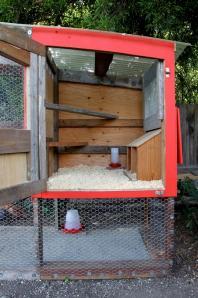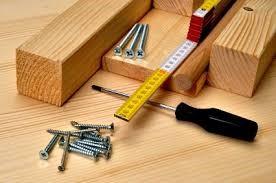Materials
When deciding which materials to use, choose those that will be easy to clean and disinfect. Materials often used to construct housing may include (but are not limited to):
- chicken coops
- chicken wire
- T-posts
- plywood
- tin (for roofing)
- chain-linked fence
- electric wire
- woven wire
Many supplies can be found at local hardware, lumber, or farm stores. Materials used are determined by the owner's budget and material availability. Do not forget to cover the top of the enclosure to keep confined birds within buildings and runs in addition to keeping predators out of the building.
Protection
The main purpose of housing poultry is protection. For many species, having outside runs in addition to housing provides additional space needed for optimal performance. To protect your birds from predators while they are exploring the outside world, confine poultry with fencing and covered runs. Covering outside runs will prevent birds of prey (hawks, owls) from entering your facility. Wire buried along the pen border will discourage predators from digging underneath the fence. Electric fencing can also be run long the outside bottom portion of the fence to further protect your flock from predators. An electric wire can be placed on the outside top of your fence in addition to a bottom strand to discourage predators from climbing over. If predators are still a concern at night (such as owls or opossums), you may want to lock up your poultry at night, especially if runs are not covered (Clauer, 1997). Certain species, such as game birds and other breeds that are fully flighted, may need to be kept within housing structures at all times.

Fences used to confine birds should be strong enough to withstand birds leaning and bumping into it. It is best to set fence posts on the outside of the fence to provide increased support.
If building a new facility, laying a concrete floor and/or starting the wall with one or two concrete blocks will aid in preventing rodents, snakes, and other predators from digging under walls and floors. Laying down a solid floor such as concrete or rubber mats will make maintaining clean facilities much easier. Packed dirt or sand is adequate, but not recommended to use for flooring because they are difficult to clean.
Windows and doors should be covered with screens when opened to prevent entry of unwanted animals and prevent the escape of confined birds! Placing doors, windows, and openings of the building away from prevailing winds will aid in keeping warmth in the winter and ventilation in the summer (Clauer, 1998). It is recommended to place openings on the south and east sides of buildings for maximum warmth and ventilation.
Remove any hazards within your facility where your birds could injure themselves. Hazards include loose wire, ails, or other sharp protruding objects from the coop. Another safety issue, commonly overlooked, is placing perches no higher than four feet above the floor (Clauer, 1998). Remember, many domestic breeds are no longer flighted and could seriously injure themselves from a fall.
Ventilation
Proper ventilation is essential when housing birds. Air movement is needed throughout the structure, but without drafts. Windows and/or fans will provide adequate ventilation within the structure supplying fresh oxygen while removing stale air. During hot weather, fans placed in housing will help prevent poultry from overheating along with providing fresh air. Proper ventilation also removes harmful gases, such as carbon dioxide (released during breathing) and ammonia (evaporated from droppings).
Have You Done the Sniff test?
Use your eyes and nose to check for correct ventilation. If you smell ammonium fumes and see thick cobwebs in your coop, then the coop is not adequatley ventilated.
Compared to other animals, many poultry species, including chickens, have a high respiration rate which causes the birds to use up the available oxygen quickly; thus, quickly increasing the amount of carbon dioxide, moisture, and heat in the air. Remember, all poultry has to pant to cool down because they have no sweat glands. Dampness and ammonia build-up are signs that there is not enough ventilation throughout the facility. Allowing moisture to accumulate on the walls and ceilings during cool weather can create many health problems for the birds. Birds can handle cold temperatures only if kept dry (Clauer, 1998). During warm weather, you may need to mount a fan in your coop to better improve cross ventilation in order to keep birds cool and remove moisture. Providing a well drained facility will aid in keeping poultry areas dry and well ventilated. Regardless of the housing you decide on, all poultry requires a dry, draft-free house to maintain good health.
Electric & Lighting
Supplying electric to, within, and around poultry areas makes it convenient when caring for poultry. Artificial light can benefit all types of poultry.
Adequate lighting will maximize production from birds. Proper artificial light during the fall and winter months will stimulate and maintain egg production in layers. Layers require a minimum of 14 hours of light per day for maximum production. One 25-watt bulb for every 40 feet is recommended for layers (Clauer, 1997). Meat birds grow well with 24 hours of light but can be grown with only 8-10 hours of light. Regardless of the type of production, all birds require one 40-watt light per 200 square feet above feeding and drinking areas. Installing an automatic timer is an inexpensive tool that can help adjust the amount of artificial light provided, but is not required.
Having electric supplied to poultry housing allows for heat lamps to be easily installed when the weather turns cold. Artificial lighting, in addition to a heat source, is very important to young poultry during the first week of life. Chicks require 24 hours of lighting during the first week of age. A heat source is necessary for all young poultry that have not grown their adult feathers.
Roosting & Nesting
The size and space of the perches used for roosting will vary depending on the size of the birds. Chickens only require six to ten inches of perch space per bird; whereas, a breeding pair of pigeons require approximately four square feet of perch space with perches having 1/8-inch diameter. Perches are used for flighted birds. Roosting is a natural behavior exhibited by flighted birds when settling down to sleep or rest. In the wild, roosting allows the birds to remain safe and high off the ground from predators while sleeping. While many domestic breeds are too heavy to fly, they still prefer to perch off the ground.
Hens like to lay their eggs in the dark, safe, and secluded places. Nest boxes encourage hens to lay their eggs in one place, making it easier to collect clean and unbroken eggs. The size of nest boxes are also determined by the species of birds being raised (Clauer, 1998). Providing at least one nest for every 4-5 birds in the flock is recommended. Nests should be placed on the ground until pullets get accustomed to using them, and secured firmly between 18-20 off the floor. Having nest boxes raised off the floor to discourage hens from scratching in them, eliminates possible damage to their eggs. Place a perch just below the entrance to give the hens a place to land when they jump up into the nest box.
Appearance
The appearance of poultry housing should be well maintained, especially housing and outside runs that are visible to the neighborhood. Proper landscaping can maintain housing appearance along with muffling sounds from birds. Ground cover, such as tall leafy vegetation, can provide cover for birds in addition to a clean appearance.
